Most boards come with them, but most paddlers don’t give a second thought to what exactly those fins are doing beneath the surface. Those who do might correctly assume fins help keep the board going in a straight line. But there’s a lot more to them than that.
Casual paddlers who aren’t interested in diving too deep into the ways fins influence a board’s performance should know that a fin is better than no fin at all. Graham Ketcheson, marketing director at Riot SUP, advises against using a paddleboard without a fin.
“You just paddle in circles,” he says. “You are always doing correction strokes and are all over the place. Especially in wind and waves, there is no directional control.”
Just how does a fin provide greater control over a paddleboard? Mike Harvey, cofounder of Badfish SUP, explains the fin acts like a keel does on a boat.
“The idea is that it counteracts the lateral force a paddle stroke puts on the board,” he continues. “If you’re paddling on the left, the board wants to turn right, and the keel or fin helps counteract that motion.”
This helps the board travel in more or less a straight line, causing less frustration for recreational paddlers and greater efficiency for touring and racing paddlers. But, fins are useful in a variety of environments and for a range of activities, including surfing and whitewater where tracking is less of a priority.
The size, shape, placement and number of fins, among other factors we won’t delve into here, all influence the board’s tracking, maneuverability, stability, speed and suitability for different environments.
Read on to shop SUP fins, understand more about the mechanics of how fins work, get buying advice on different types of fins, and see the answers to the most commonly asked questions about SUP fins.
Paddleboard fin buying advice
Setups and fins for different types of boards
When it comes to touring and race boards, tracking and speed are a priority. These boards usually have a single-fin setup—the more fins in the water, the more effort it will take to paddle. The fin on a touring or race board is typically long and curved at varying degrees, the large surface area of the fin providing better tracking and stability, the latter of which is important on narrow race boards. Racers and long-distance paddlers will often position the fin toward the tail of the SUP’s fin box, which helps the tail hold and also results in straighter tracking. The trade-off for better tracking? The board will also be more difficult to turn.
Whitewater paddlers and SUP surfers need their boards to be able to turn quickly. These boards typically have shorter fins, enabling quicker turns but providing less stability. To compensate, these boards have a three-fin setup with a center fin and two smaller fins called side bites or thrusters. The side bites add traction to avoid slippage—preventing the tail end of the board from spinning or sliding side to side.
Harvey explains the side bites also help shorten the turning radius of the board and generate speed. Water is channeled between the fins, creating pressure and allowing paddlers to push against the water in the same way a snowboarder would apply pressure to the heel or toe edge of their board to turn or adjust speed.
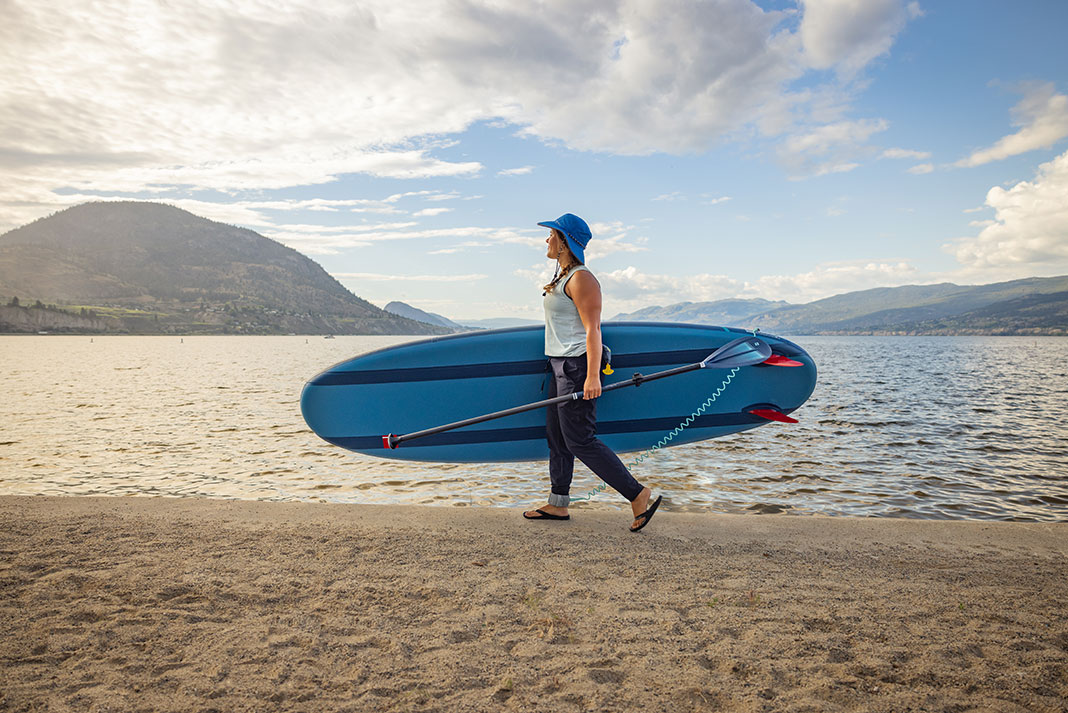
Unlike touring boards, whitewater and surf SUPs will often position the center fin toward the front of the fin box, releasing the tail to maneuver the paddleboard more easily.
Recreational paddlers will see a mix of single- and three-fin configurations on all-around paddleboards. Many inflatable SUPs have a three-fin setup, which works well for beginners as the side bites provide extra stability and assist in turning.
Fin shapes
One of the most versatile center fin shapes you’ll see across a variety of board types, especially all-purpose boards, is a dolphin fin. If you imagine the quintessential surfboard fin you are likely picturing a dolphin fin. These fins are curved, taper toward the tip, and have a concave backside—as opposed to touring fins which, although curved, have less taper and a straighter backside. The curved shape of the dolphin fin provides good stability and tracking, while the carved out area at the back decreases the surface area and resistance to provide greater carving and turning ability—particularly helpful when surfing.
Setups according to environment
Environment is a consideration, too. If you think you’ll spend time on both lakes and rivers, Harvey says a three-fin setup with removable fins is best as it provides “more flexibility for different configurations.” This way you can use a single-fin setup on lakes and three smaller fins on rivers, providing “more square inches of fin in the water, but no fin protruding very far,” striking a balance between avoiding catching rocks and maintaining good traction.
That said, rivers are the one environment where paddlers sometimes opt to go finless, especially in low water levels.
“In a river, people are concerned with catching a fin on rocks. In rivers, you can paddle finless, although I never do,” says Harvey. “If you paddle in a river finless you are going to have trouble generating speed in a line.”
Retractable fins, which require a special fin box, are also an option for paddling in rivers and can reduce potential damage to the board in low water. Ketcheson adds that a retractable fin is also appropriate “if you are going down a shallow creek or a coastal estuary at low tide.”
Fin questions & answers
-
Do paddleboards have fins?
The fins of a paddleboard might be hard to notice as they are often underwater, but paddleboards do in fact have fins. Paddleboards generally have between one and three fins, with surfing or whitewater paddleboards sometimes having up to five fins.
-
Why do paddleboards have fins?
Paddleboards have fins for a few reasons, the main one being to help you paddle in a straight line, also known as tracking. Without a fin, the back end of the paddleboard would have much more side to side movement across the water, each paddle stroke causing the paddleboard to move in a zigzag pattern. Fins can also generate speed and power on waves. And the fin position on the paddleboard can be altered to affect maneuverability. Lastly, fins add to the stability of a paddleboard.
-
What is the fin on a paddleboard called?
The fin on a paddleboard is called just that, a fin. The small fins used in surfing and whitewater are often referred to as thruster fins, side fins or side bites. Some of the paddleboard fin shapes have different names, such as dolphin fins, which are curved, taper toward the tip, and have a concave backside.
-
Can you paddleboard without a fin?
Paddleboarding without a fin is not recommended as it is the key component for control over steering. It is sometimes advantageous to paddle without a fin in whitewater when a paddler is concerned with hitting the fin on rocks in shallow waters; however your steering capabilities take a big hit.
-
Are paddleboard fins universal?
Paddleboard fins come in many shapes and sizes, optimized for different intended uses, and therefore are not universal. There can be differences in paddleboard fin boxes which do not allow for all types of fins to be compatible. Some fins will however be compatible across multiple paddleboards.
-
How many fins should a paddleboard have?
A paddleboard should have at least one fin. Sometimes paddleboards can have between two and five fins, with one fin or three fins being the most common configurations.
-
Paddleboard fin size
Center fins on a paddleboard are typically around eight or nine inches in length. The side fins are smaller, generally around 4.5 inches, but can vary from three to seven inches.
-
Is more fins better on a paddleboard?
More fins on a paddleboard could be better, but it really depends how the paddleboard is being used. If your aim is to go fairly straight on the water, less fins is more. If you need good directional control, the more fins the merrier.
-
Can you replace a fin on a paddleboard?
Yes, if a paddleboard fin is removable, it can be replaced. If a paddleboard fin is permanently affixed to the board, either molded on or manufactured as part of the paddleboard, it cannot be replaced. This is often the case with thruster fins on inflatable paddleboards.
Removable fins are often secured with plastic tabs, metal screws or a click-in keyless fin configuration. For removable fins, the paddleboard distributor should sell replacement fins and parts if you damage one or lose a screw or screw plate. You can also choose to upgrade your fin for better performance or to select a different size, shape or material.
-
How to put a fin on inflatable paddleboard
Prior to the installation of a fin on an inflatable paddleboard, ensure the paddleboard is inflated to the correct pressure for use. Inflatable paddleboards typically use a screw-in fin system. First, align the screw plate within the grooved slot in the fin box and push the plate as far forward as possible. Ensure the fin is in the correct orientation, with the sweep or taper of the fin pointing toward the back of the paddleboard. Place the metal pins of the fin into the groove of the fin box and slide the fin into place and to its desired positioning within the fin box. Move the screw plate as needed to ensure it lines up with the front hole in the fin and secure the fin in place with a screw. Tighten the screw with a fin key.
-
Paddleboard fin direction
Here’s an easy way to remember the correct paddleboard fin direction. Picture a shark’s dorsal fin, which tapers or curves from the nose back toward the tail—a paddleboard fin does the same and is essentially an upside down shark fin. The taper or curvature of the SUP fin should point toward the back of the paddleboard.
In screw-in fin systems, generally the back of the fin contains a metal pin to slide within the grooves of the fin box and the front of the fin contains a screw hole. In tool-less fin systems, the front of the fin will contain the metal pin.
-
How to remove fin from paddleboard
The first step in removing a fin from a paddleboard is to place the paddleboard on a sturdy surface with the bottom of the paddleboard facing upward. First, confirm the fins are in fact removable and not molded or manufactured into the paddleboard. Removable fins are identified by locating a fin box which either has a removable screw or plastic tab, or an obvious slot where a fin can slide.
To remove a fin that is screwed in, first unscrew and remove the screw from the fin. Pry the top of the fin down toward the tail end of the board so the front of the fin is released from the fin box. Slide the pin at the back of the fin along the groove of the fin box, to the opening and out of the fin box. Carefully remove the screw plate and ensure the screw plate and screw are kept with the fin.
To remove small thruster fins, unscrew and remove the set screws that hold the fin in place, and then pull the fins directly up and out of the paddleboard fin box.
For tool-less fin systems that don’t use a screw or screw plate, apply pressure to the end of the fin on the underside to push the fin up and forward. This will release the back of the fin from the fin box, allowing you to then slide the pin at the front of the fin toward the opening to be removed.
For additional configurations, look to remove the securing mechanism, such as a plastic tab, and then to release the fin from the fin box by sliding it out of the channel holding it in place.
-
How do I know what fin box I have?
The majority of paddleboarders won’t ever need to know what fin box they have as manufacturers and retailers have replacement parts and compatible options based on what paddleboard brand and model you have. If you do need to determine what fin box you have, it may require some investigating. Begin by checking the fin box on your paddleboard to see if it contains a label such as FCS, which is fairly common. Contact the paddleboard manufacturer or a fin manufacturer such as FCS or Black Project SUP to determine which of their SUP fins are compatible with your paddleboard.
Related articles
Get more expert paddleboard buying advice to help narrow your search for the perfect SUP.
- Best Cheap Paddleboards For 2024
- Best Beginner Paddleboards For 2024
- Best Paddleboards For Dogs: A Beginner’s Guide
- Best Amazon Paddleboards For 2024
- Best Costco Paddleboards For 2024
- Paddleboard Types You Should Know About Before You Buy
- How To Size A Paddleboard
- What’s The Difference Between A Kayak And A Paddleboard?
- How Much Are Paddleboards?
- Best SUP Brands For Touring, Surfing, Yoga & More
One fin, two fin, red fin, blue fin; Black fin, blue fin, old fin, new fin; This one will provide stability; This one will improve turn-ability; Say! What a lot of fins there are. | Feature photo: Tony Felgueiras Photography



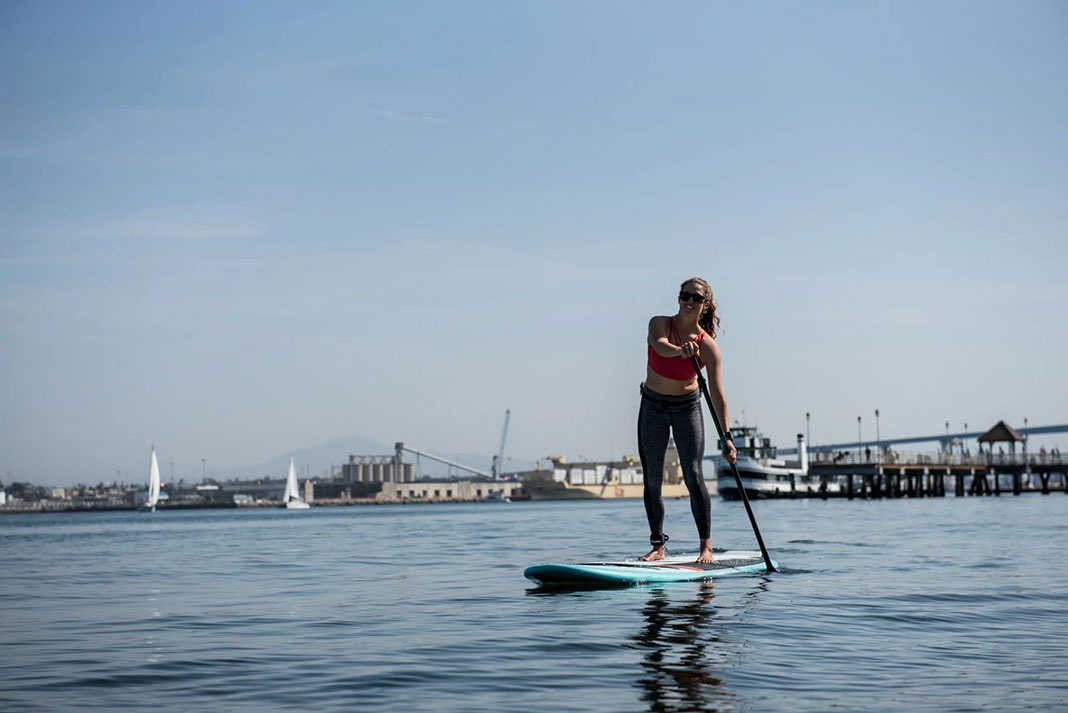
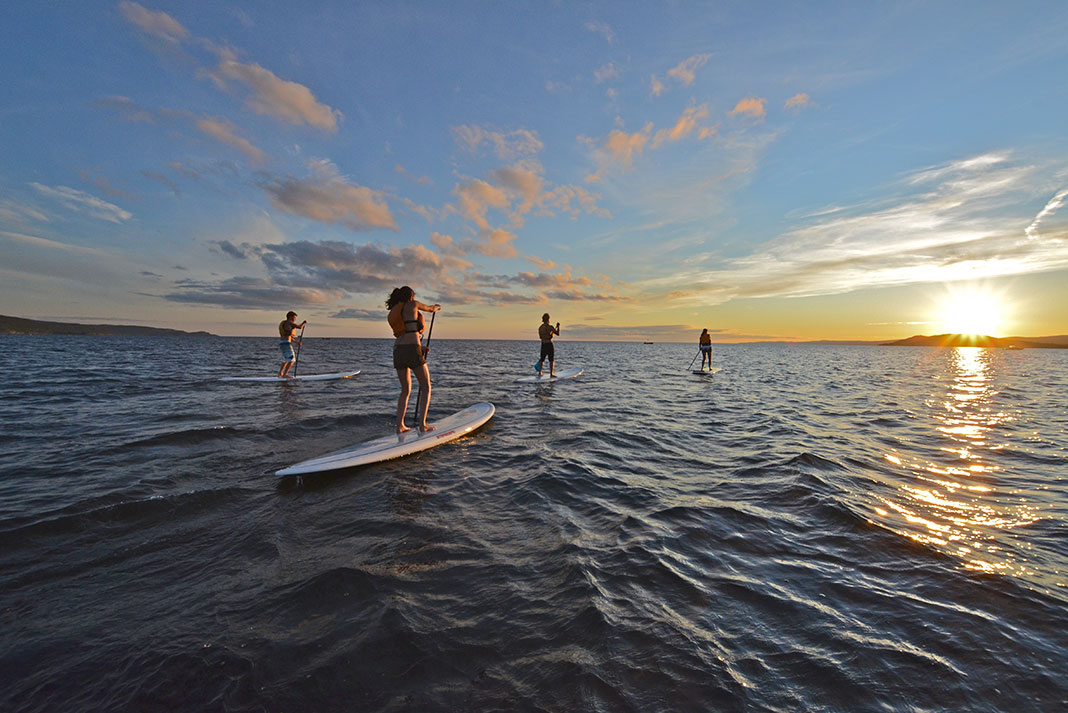
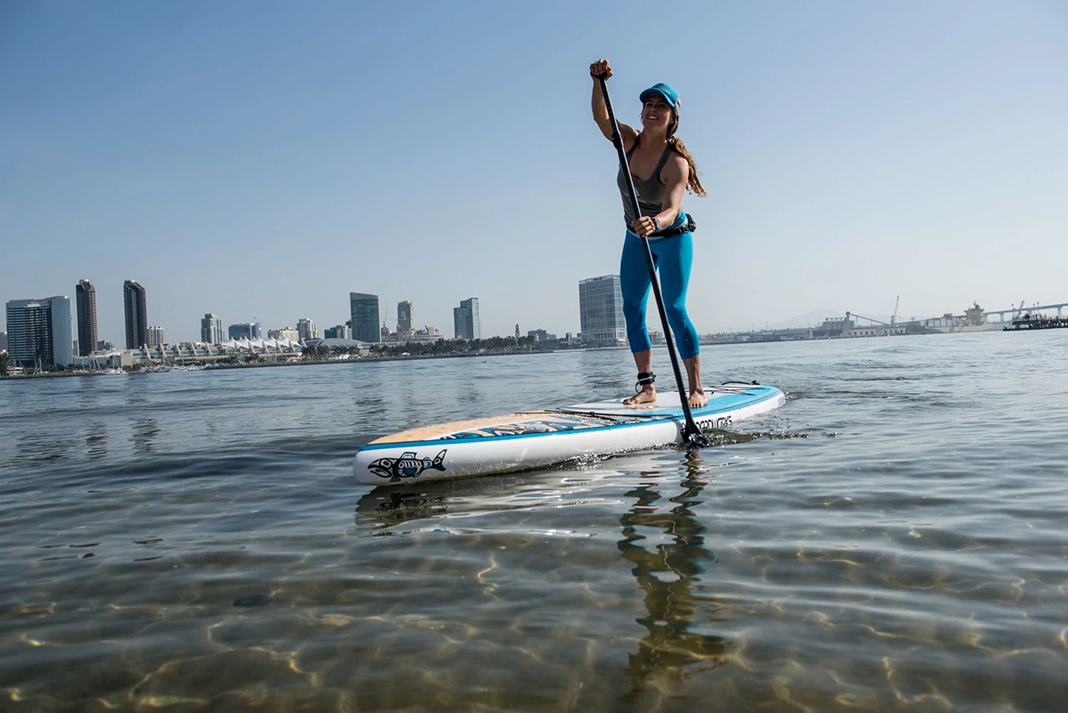
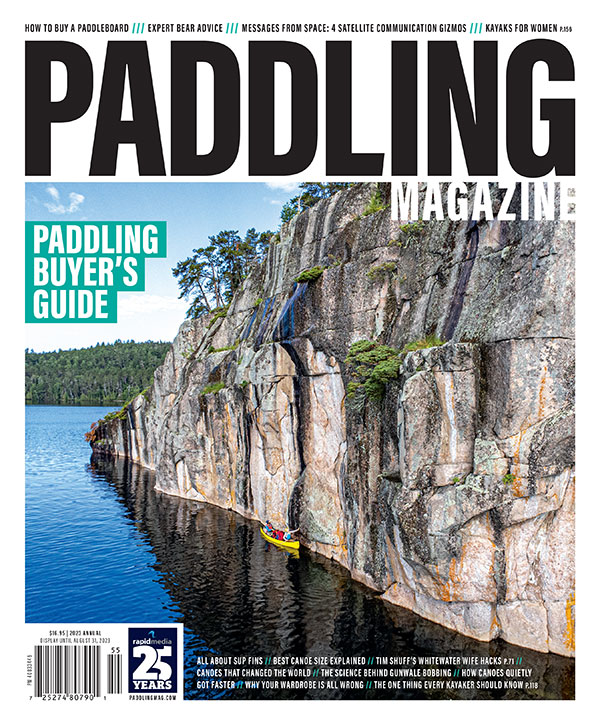 This article was first published in the 2023 Paddling Buyer’s Guide.
This article was first published in the 2023 Paddling Buyer’s Guide. 
